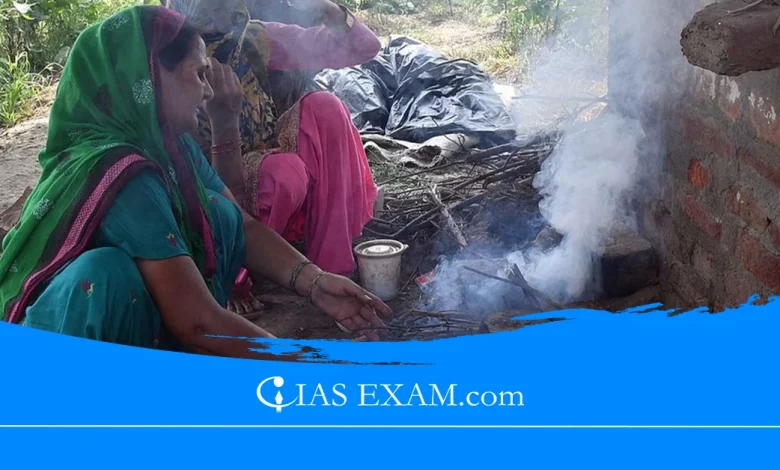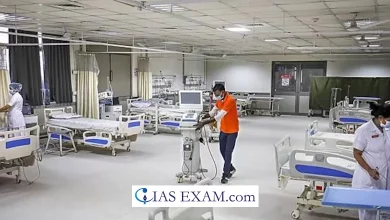Challenges associated with Black Carbon Emissions
GS Paper 2 - Environment and Climate Change

Context
The COP26 climate talks in Glasgow 2021, witnessed significant pledges and commitments towards addressing climate change, with India emerging as a frontrunner by pledging to achieve net-zero emissions by 2070.
India’s ambitious renewable energy targets, including the installation of over 180 GW of renewable energy capacity by 2023 and a planned 500 GW by 2030, demonstrate its commitment to carbon neutrality and sustainable development. However, amidst these efforts, the challenge of black carbon emissions looms large, presenting complex challenges that require immediate attention and action.
Understanding Black Carbon
- Black carbon, often referred to as soot, is a potent climate pollutant formed by incomplete combustion of fossil fuels, biomass, and biofuels.
- Unlike carbon dioxide, which remains in the atmosphere for centuries, black carbon has a relatively short atmospheric lifespan but exerts a significant warming effect, particularly in regions with snow and ice.
- Its impacts extend beyond climate change, contributing to air pollution, respiratory illnesses, and ecosystem degradation.
- There is a direct link between exposure to black carbon and a higher risk of heart disease, birth complications, and premature death. Most black carbon emissions in India arise from burning biomass, such as cow dung or straw, in traditional cookstoves.
Challenges Associated with Black Carbon Emissions
The reduction of black carbon emissions poses unique challenges that must be addressed to achieve meaningful climate action.
- Unlike carbon dioxide, which is emitted from various sources and sectors, black carbon emissions are primarily linked to specific activities such as inefficient cookstoves, diesel engines, and industrial processes. This concentrated emission profile necessitates targeted mitigation strategies tailored to these sources.
- According to RTI data(2022-2023): 25% of all PMUY beneficiaries availed either zero LPG refill or only one LPG refill. They still relied entirely on traditional biomass for cooking.
- The average PMUY beneficiary household consumes only 3.5-4 LPG cylinders per year instead of the six or seven a regular non-PMUY household uses. Half of all the energy needs of a PMUY beneficiary household are still met by traditional fuels.
- A shortage of LPG and higher usage of traditional fuels affect women and children disproportionately. They are more prone to higher levels of indoor air pollution, causing many health issues and leading to premature deaths.
- One of the main challenges in mitigating black carbon emissions lies in addressing the diverse sources and sectors responsible for its production. Household cooking and heating, transportation, and industrial activities are major contributors to black carbon emissions, each requiring tailored solutions to achieve significant reductions.
- Another challenge is the transboundary nature of black carbon emissions, which can travel long distances and affect regions far from the source of emission. This highlights the importance of international cooperation and coordination in tackling black carbon pollution effectively.
Solutions and Opportunities
Addressing black carbon emissions requires a multifaceted approach that combines technological innovation, policy interventions, and behavioral change.
- Investing in clean cooking technologies, such as improved cookstoves and clean fuels, can significantly reduce household emissions while improving indoor air quality and public health.
- Similarly, promoting the adoption of cleaner fuels and emission controls in transportation and industrial sectors can help curb emissions from diesel engines and industrial processes.
- Policy interventions, such as regulatory standards and incentives for clean technologies, play a crucial role in driving black carbon mitigation efforts. International initiatives, such as the Climate and Clean Air Coalition (CCAC) and the Global Alliance for Clean Cookstoves, provide platforms for collaboration and knowledge-sharing among countries to accelerate black carbon reduction efforts.
- Prioritizing black carbon reduction through initiatives such as the PMUY scheme can help India become a global leader in addressing regional health concerns. It will help meet its Sustainability Development Goal of providing affordable clean energy to everyone and contributing to global climate mitigation.
- A high carbon tax across China, the U.SIndia, Russia, and Japan alone (more than 60% of global effluents), with complementary actions, could have a notable effect on global effluents and warming. It could also pave the way to seeing decarbonisation as a winning development formula.
Conclusion
The challenge of black carbon emissions presents a complex but surmountable obstacle in the fight against climate change. By implementing targeted mitigation strategies, promoting international cooperation, and leveraging co-benefits for air quality and public health, we can effectively reduce black carbon emissions and mitigate its impacts on the climate and environment. As India and other nations pursue their climate goals, addressing black carbon emissions must remain a priority to achieve a sustainable and resilient future for all.
SOURCE: The Hindu





.png)



